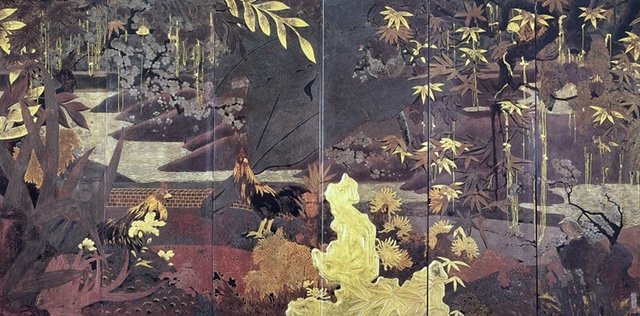Pham Hau « Roosters In a Landscape » c. 1940 or the fable of animals
In this magnificent screen of very large format (six panels of 135 X 44 cm each, in all 135 X 264 cm), signed on the lower right, Pham Hau (1903-1995) by his technical virtuosity, restores all the splendour and the precision of the art of the Vietnamese lacquer.

It is a fact that, Pham Hau, like all painter and particularly lacquer painters using so many layers, does not hesitate to reuse certain graphic elements of his work to facilitate his task.
It can be seen in the repetitive “golden” vines that streak the composition.
In the same way, the semi-abstract composition, the geometrical motifs and the general aesthetics of the work are borrowed from Jean Dunand and his disciples. We have already mentioned everything that Vietnamese lacquer art owes to Jean Dunand through his teachings at the Hanoi School of Fine Arts.
Internal and external borrowings are the two pillars of the artist in general. Only his talent avoids repetition.
Pham Hau offers here a truly extraordinary work. Over the years since his graduation from the Hanoi School of Fine Arts in 1934, Pham Hau’s lacquers have their public, essentially the French “colonials” who love decorating their homes. It is most likely this lacquer was a special order, most certainly for a Frenchman, as the work was imported there a long time ago.
If on the one hand, the artist here does not use repetition of his usual themes – deer, pagodas, Ha Long Bay – with the help of his workshop. It is, on the other hand, a unique work (subject to inventory) where he seems more playful with his viewer.
Two roosters appear in the forefront of this abundance of gold – the vegetation, the rocks but also the undulating water of the river and the barriers – painted, in relief, in different tones, in flat tints or dots, in this “mineral” vegetation that falls like an avalanche, the shiny surfaces and the dullnesses.
Proud, imposing, they occupy almost all the lower left quarter of the lacquer.
In the opposite, discreet, almost hidden, two pheasants in the upper center, on the right and an egret on the lower right appear. To better conceal these three birds, Pham Hau paints them in dark colors on a dark background and depicts them in a much smaller size than the two roosters. The five animals and the rock are the central elements of the work, with the abundant vegetation almost phantasmagorical serving as a backdrop.
Such an unusual modus operandi cannot be anecdotal. What does the painter want to tell us in this very personal work?
Of course, evoking the symbolism inherited from China is the usual temptation to enlighten the painting. But it seems to me that here, we cannot be satisfied with a simple juxtaposition of pattern and symbol. No, the work must be rightly interpreted in the spirit of the late 1930s and early 1940s.
Our screen can be dated around 1940-42 given the type of its signature. At that time it was much simpler. The old one was previously in Chinese characters, accompanied by a sophisticated seal – and less legible for many amateurs… -. Around 1940, Pham Hau began to sign his works with his name in Roman characters here below (sometimes added to his name in Chinese characters as shown here).
Asian symbolism?
The egret symbolizes long life and immortality; it is, as in classical Chinese iconography, associated with a rock and a tree, in this case a cherry tree, which symbolizes renewal and virginity. The two roosters can be symbols of ostentation and vanity. Finally, the pheasants are symbols of beauty and good luck.
Contemporary reinterpretation?
What if the two roosters symbolized France (the “Gallic rooster” is one of the country’s emblems), the egret Vietnam and the pheasants political actors?
The size of the former , their central place in the work , symbolizing the French colonial presence, the pheasants in couple embodying the two trends, evolution-revolution, competing for the monopoly of the struggle for independence against the French colonial power, and the triple alliance egret-rock-cherry Vietnam in waiting …
All this, expressed allusively and poetically, would be in keeping with the vocation of the work, its public, the artist’s conscience and the historical context of the moment.
A fable is always based on reality.
Jean-François Hubert